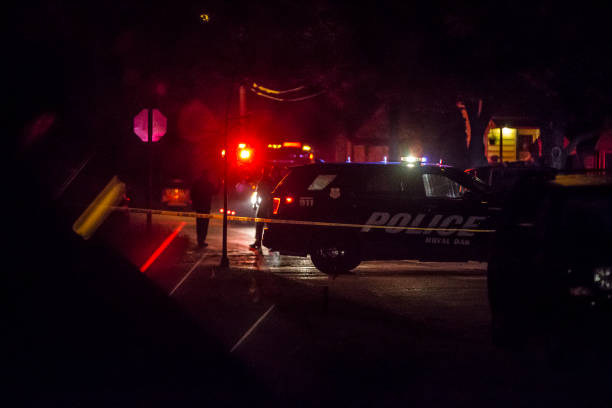A peaceful Tuesday evening in Dallas County, Iowa was abruptly broken by tragedy when Douglas Randolph, a 53-year-old man from Adel, lost his life in a fatal motorcycle crash. The accident occurred shortly after 8:24 p.m. near the intersection of Old Highway 6 and L Avenue, a stretch of rural road bordered by open land and quiet fields—now marked by the memory of a devastating loss.
The Dallas County Sheriff’s Office confirmed that Randolph was the sole rider and only individual involved in the accident. When law enforcement and emergency personnel responded to the call, they found a motorcycle crashed off the roadway and Randolph lying unconscious nearby. Emergency crews, including paramedics and deputies, immediately attempted life-saving measures, including CPR, but despite their urgent efforts, Randolph was pronounced dead at the scene.
Preliminary investigation findings suggest that Randolph had been traveling at a high rate of speed as he attempted to navigate a curve in the roadway. The combination of excessive speed and the turn’s geometry likely led him to lose control, veering the motorcycle off the pavement and into a ditch. There were no other vehicles involved, and officials have made no initial statements about road conditions, debris, or wildlife as possible contributing factors.
The site of the crash—a rural stretch near Old Highway 6, known for its winding lanes and lack of lighting after dusk—presents hazards that, under high speed or low visibility, can be unforgiving. The specifics of Randolph’s intended destination, the circumstances of his travel, and his actions leading up to the crash remain under investigation, as authorities work to understand exactly what led to the fatal moment. Whether he was returning home, going for a late-evening ride, or en route to visit someone remains unknown.
As is customary in fatal crashes, authorities will likely conduct toxicology testing, though no indication has yet been given that alcohol, drugs, or other impairing substances were involved. Such tests, while standard, take time and are meant to provide a complete forensic picture of the incident. Likewise, the condition of the motorcycle, including possible mechanical issues or tire conditions, may be evaluated.
The fatal crash serves as a powerful reminder of the unique dangers that come with motorcycle riding—particularly in situations involving high speed. Unlike drivers in enclosed vehicles, motorcycle riders face significantly greater vulnerability, with limited physical protection and a higher risk of fatal injury in the event of loss of control. Even seasoned riders can be caught off guard by unexpected curves, gravel shoulders, or momentary lapses in judgment. What might be survivable in a car can quickly become deadly on two wheels.
Douglas Randolph’s death sends ripples through the community of Adel, a small city where familiarity is common and news of fatal accidents often hits close to home. Randolph, who was likely known to fellow residents—whether through work, friendships, or community events—has now become the latest name added to the solemn statistics of Iowa traffic fatalities. While no public statements have yet been issued by his family or close friends, it is expected that tributes and memorial gatherings may follow in the days to come.
The emotional toll of such an accident cannot be understated. The trauma endured by first responders, especially in single-fatality events where immediate intervention proves unsuccessful, is something that lingers. Paramedics, deputies, and firefighters who rushed to the scene did so with the full weight of their duty—to preserve life where possible, and to provide dignity where it is not.
Beyond the personal and emotional fallout, law enforcement has seized the opportunity to emphasize road safety, especially for motorcyclists. The Dallas County Sheriff’s Office, like many departments across the country, regularly encourages riders to obey posted speed limits, to be cautious on unfamiliar or curved roads, and to wear appropriate safety gear, including helmets, protective jackets, and boots. While it is unknown what Randolph was wearing at the time of the crash, safety advocates have long noted that protective gear can often be the deciding factor between injury and fatality.
The stretch of road where the crash occurred is emblematic of a broader challenge facing rural drivers and riders. While less congested than urban streets, country highways can present unique perils: poor lighting, soft shoulders, sudden curves, and wildlife crossings are just a few of the variables that can render even routine travel risky. For motorcyclists, these hazards are magnified by the physical nature of their vehicles and the often-higher speeds associated with highway travel.
The investigation remains ongoing, and officials have signaled that further updates will be provided as more facts are established. This may include more information about the motorcycle’s make and model, Randolph’s riding experience, and the environmental conditions at the time of the crash. Such information, while technical, is essential in forming a comprehensive understanding of why the accident happened—and whether any factors beyond rider error may have played a role.
For now, though, what remains is a community in mourning, a family left grieving, and a road bearing the tragic imprint of a life lost too soon. Whether Douglas Randolph was an experienced rider or someone newer to the roads, his death underscores a stark truth: motorcycle safety is not just about skill, but about constant vigilance, judgment, and respect for the road’s inherent unpredictability.
As investigations continue and the community processes its loss, the hope remains that others may learn from this tragedy—that riders will slow down, drive defensively, and understand that sometimes, even the smallest miscalculation on a curve can lead to irreversible consequences.

